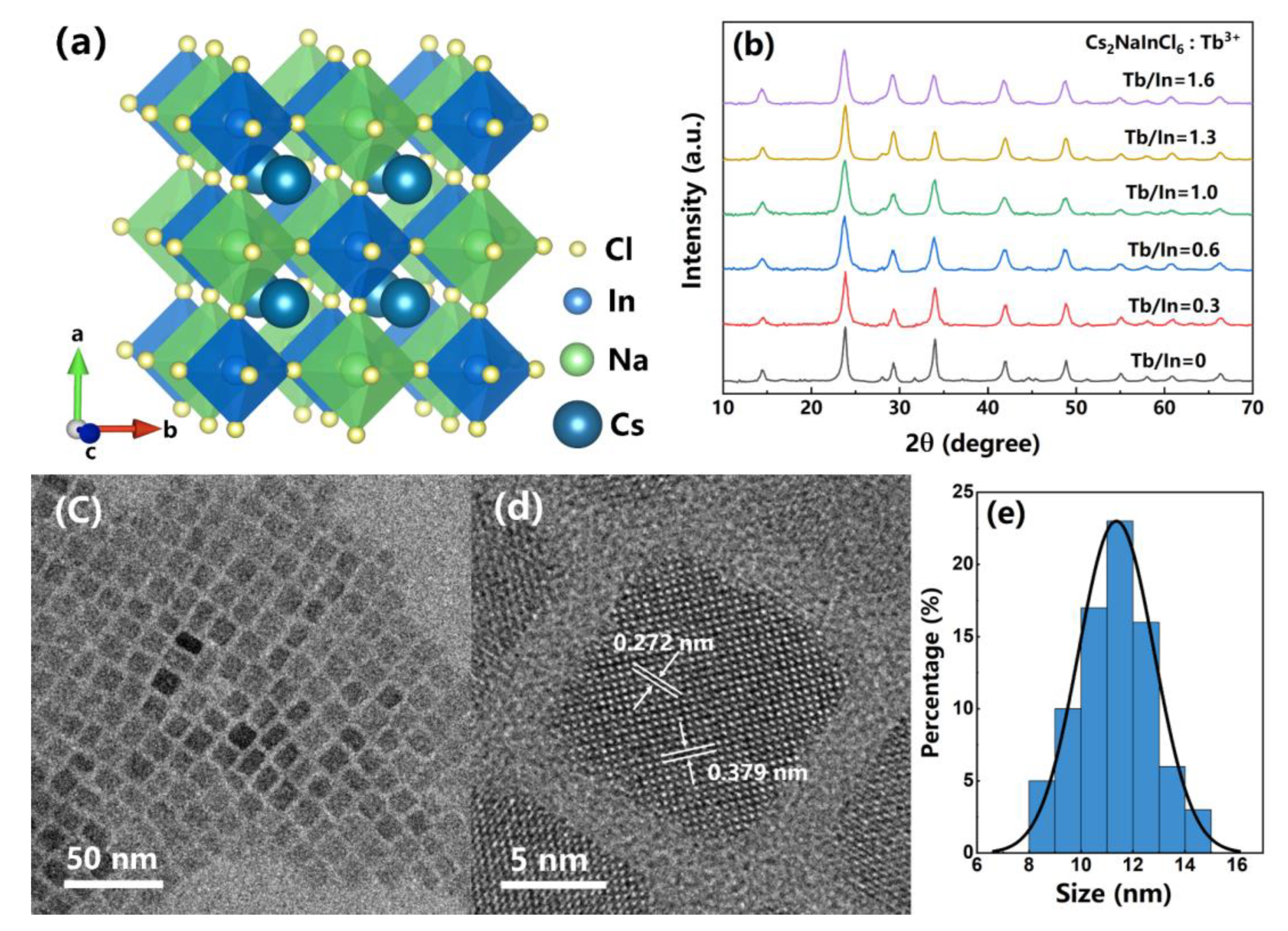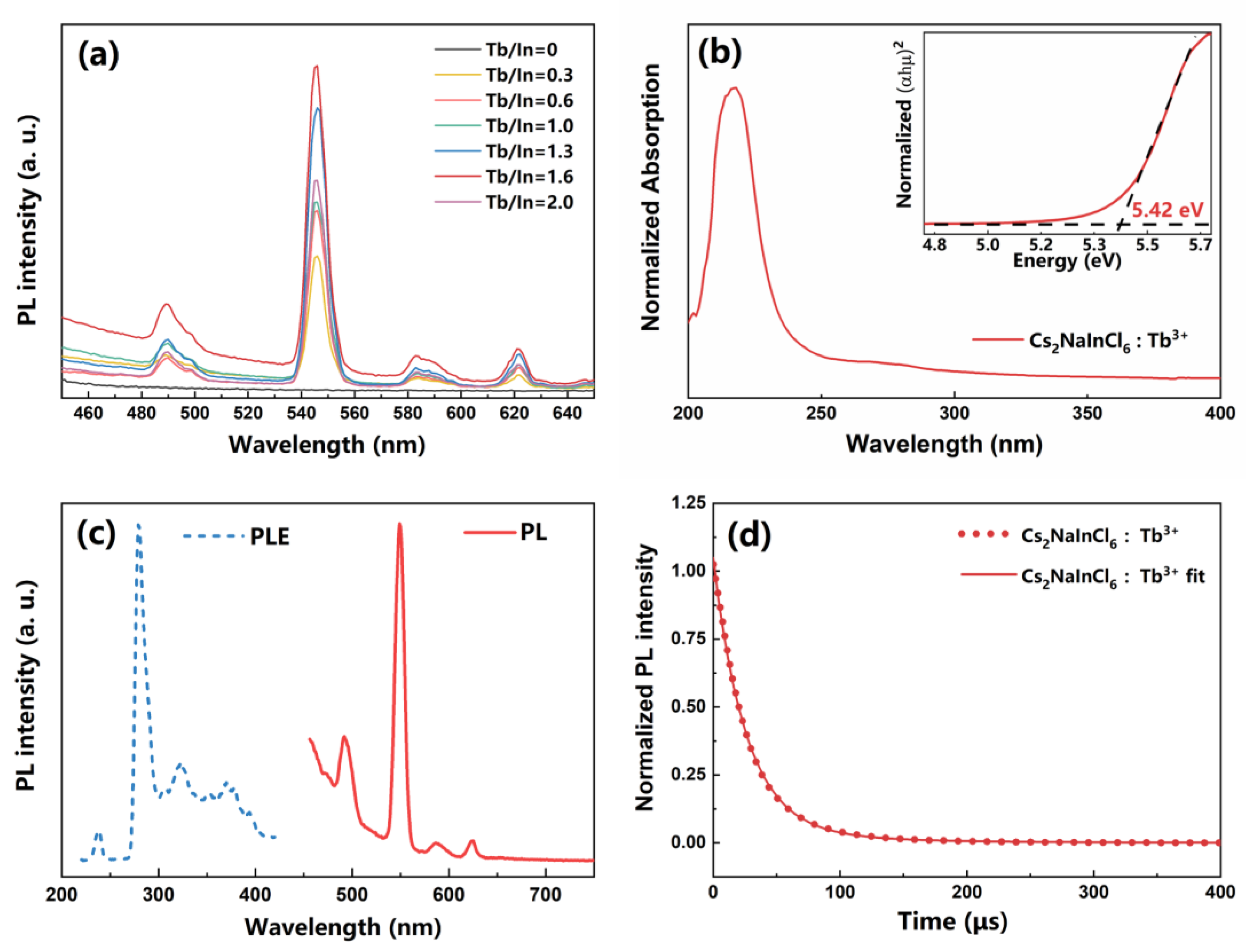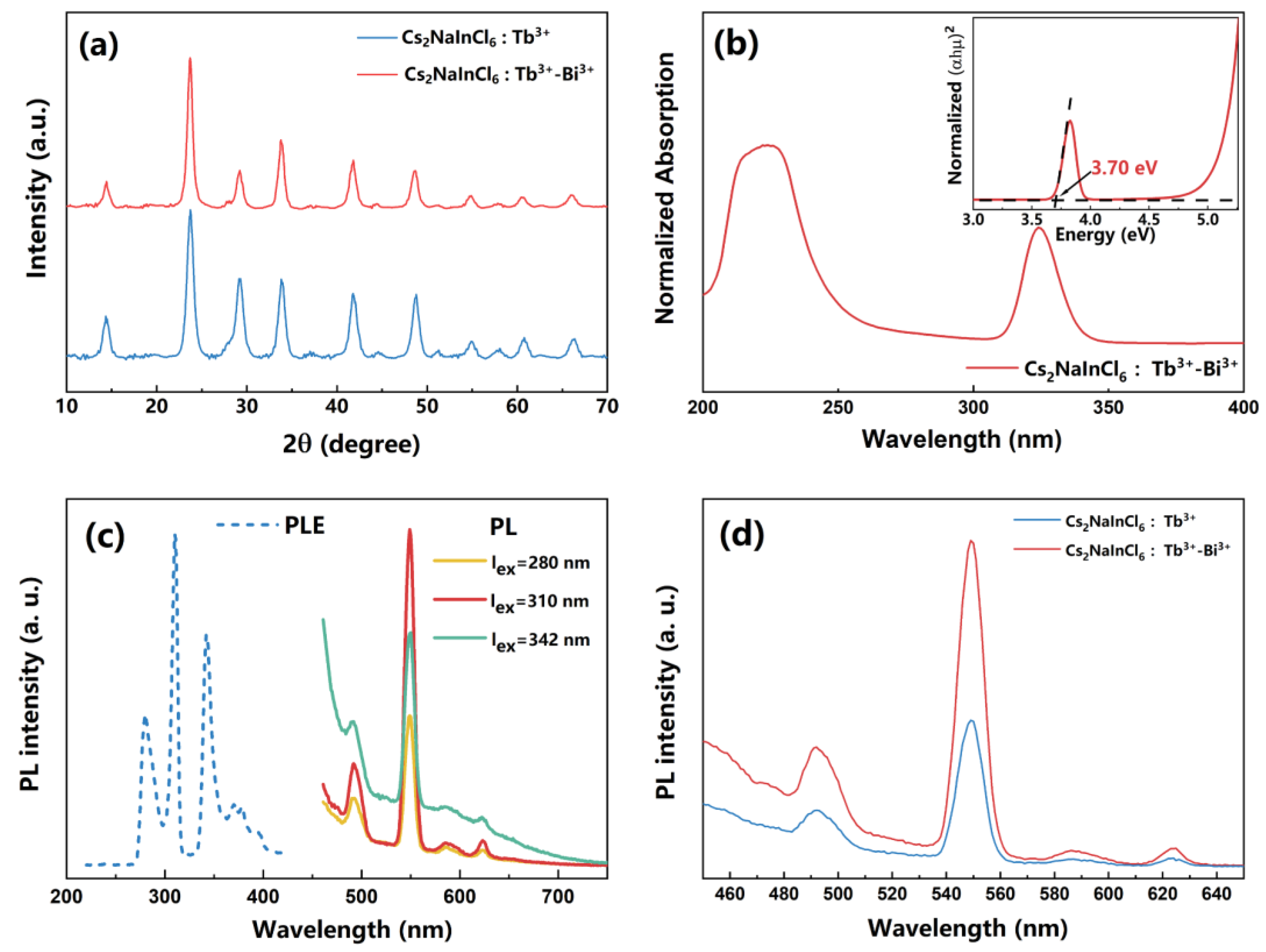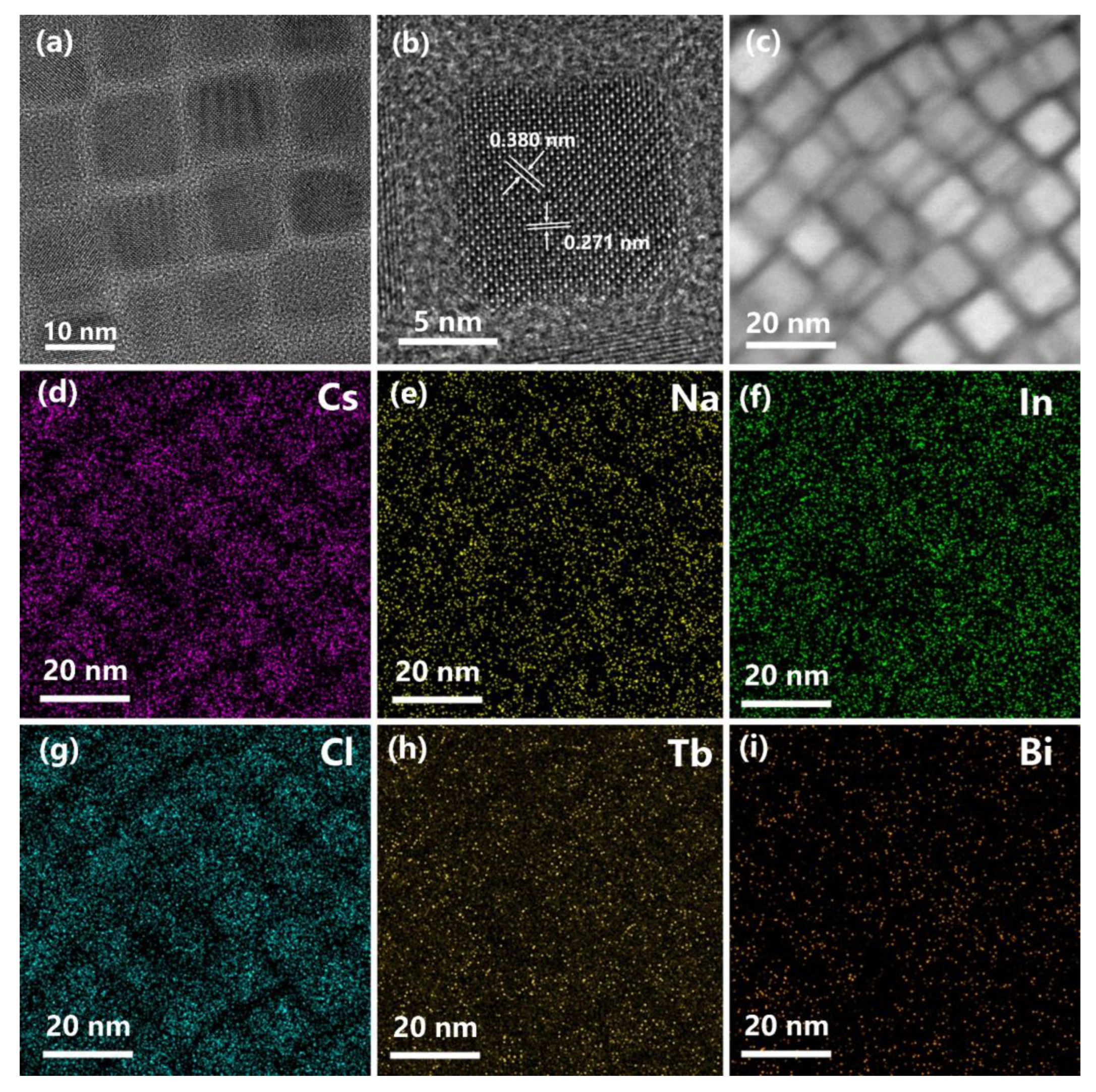Tb3+ and Bi3+ Co-Doping of Lead-Free Cs2NaInCl6 Double Perovskite Nanocrystals for Tailoring Optical Properties
Abstract
1. Introduction
2. Materials and Methods
3. Results and Discussion
4. Conclusions
Author Contributions
Funding
Data Availability Statement
Conflicts of Interest
References
- Lee, M.M.; Teuscher, J.; Miyasaka, T.; Murakami, T.N.; Snaith, H.J. Efficient Hybrid Solar Cells Based on Meso-Superstructured Organometal Halide Perovskites. Science 2012, 338, 643–647. [Google Scholar] [CrossRef]
- Yang, Y.; Hoang, M.T.; Bhardwaj, A.; Wilhelm, M.; Mathur, S.; Wang, H. Perovskite Solar Cells Based Self-Charging Power Packs: Fundamentals, Applications and Challenges. Nano Energy 2022, 94, 106910. [Google Scholar] [CrossRef]
- Burschka, J.; Pellet, N.; Moon, S.-J.; Humphry-Baker, R.; Gao, P.; Nazeeruddin, M.K.; Graetzel, M. Sequential Deposition as a Route to High-Performance Perovskite-Sensitized Solar Cells. Nature 2013, 499, 316–319. [Google Scholar] [CrossRef]
- Yuan, M.; Quan, L.N.; Comin, R.; Walters, G.; Sabatini, R.; Voznyy, O.; Hoogland, S.; Zhao, Y.; Beauregard, E.M.; Kanjanaboos, P.; et al. Perovskite Energy Funnels for Efficient Light-Emitting Diodes. Nat. Nanotechnol. 2016, 11, 872–877. [Google Scholar] [CrossRef] [PubMed]
- Lin, K.; Xing, J.; Quan, L.N.; de Arquer, F.P.G.; Gong, X.; Lu, J.; Xie, L.; Zhao, W.; Zhang, D.; Yan, C.; et al. Perovskite Light-Emitting Diodes with External Quantum Efficiency Exceeding 20 Percent. Nature 2018, 562, 245–248. [Google Scholar] [CrossRef]
- Wang, Y.; Li, X.; Song, J.; Xiao, L.; Zeng, H.; Sun, H. All-Inorganic Colloidal Perovskite Quantum Dots: A New Class of Lasing Materials with Favorable Characteristics. Adv. Mater. 2015, 27, 7101–7108. [Google Scholar] [CrossRef] [PubMed]
- Sutherland, B.R.; Sargent, E.H. Perovskite Photonic Sources. Nat. Photonics 2016, 10, 295–302. [Google Scholar] [CrossRef]
- Giustino, F.; Snaith, H.J. Toward Lead-Free Perovskite Solar Cells. ACS Energy Lett. 2016, 1, 1233–1240. [Google Scholar] [CrossRef]
- Liang, L.; Gao, P. Lead-Free Hybrid Perovskite Absorbers for Viable Application: Can We Eat the Cake and Have It Too? Adv. Sci. 2018, 5, 1700331. [Google Scholar] [CrossRef]
- Wu, X.; Song, W.; Li, Q.; Zhao, X.; He, D.; Quan, Z. Synthesis of Lead-Free CsGeI2 Perovskite Colloidal Nanocrystals and Electron Beam-Induced Transformations. Chem. Asian J. 2018, 13, 1654–1659. [Google Scholar] [CrossRef]
- Jellicoe, T.C.; Richter, J.M.; Glass, H.F.J.; Tabachnyk, M.; Brady, R.; Dutton, S.E.; Rao, A.; Friend, R.H.; Credgington, D.; Greenham, N.C.; et al. Synthesis and Optical Properties of Lead-Free Cesium Tin Halide Perovskite Nanocrystals. J. Am. Chem. Soc. 2016, 138, 2941–2944. [Google Scholar] [CrossRef]
- Du, K.; Meng, W.; Wang, X.; Yan, Y.; Mitzi, D.B. Bandgap Engineering of Lead-Free Double Perovskite Cs2AgBiBr6 through Trivalent Metal Alloying. Angew. Chem. Int. Ed. 2017, 56, 8158–8162. [Google Scholar] [CrossRef] [PubMed]
- Meng, W.; Wang, X.; Xiao, Z.; Wang, J.; Mitzi, D.B.; Yan, Y. Parity-Forbidden Transitions and Their Impact on the Optical Absorption Properties of Lead-Free Metal Halide Perovskites and Double Perovskites. J. Phys. Chem. Lett. 2017, 8, 2999–3007. [Google Scholar] [CrossRef] [PubMed]
- Karmakar, A.; Dodd, M.S.; Agnihotri, S.; Ravera, E.; Michaelis, V.K. Cu(II)-Doped Cs2SbAgCl6 Double Perovskite: A Lead-Free, Low-Bandgap Material. Chem. Mater. 2018, 30, 8280–8290. [Google Scholar] [CrossRef]
- Han, P.; Han, K. Recent Advances in All-Inorganic Lead-Free Three-Dimensional Halide Double Perovskite Nanocrystals. Energy Fuels 2021, 35, 18871–18887. [Google Scholar] [CrossRef]
- Li, S.; Hu, Q.; Luo, J.; Jin, T.; Liu, J.; Li, J.; Tan, Z.; Han, Y.; Zheng, Z.; Zhai, T.; et al. Self-Trapped Exciton to Dopant Energy Transfer in Rare Earth Doped Lead-Free Double Perovskite. Adv. Opt. Mater. 2019, 7, 1901098. [Google Scholar] [CrossRef]
- Chen, N.; Cai, T.; Li, W.; Hills-Kimball, K.; Yang, H.; Que, M.; Nagaoka, Y.; Liu, Z.; Yang, D.; Dong, A.; et al. Yb- and Mn-Doped Lead-Free Double Perovskite Cs2AgBiX6 (X = Cl–, Br–) Nanocrystals. ACS Appl. Mater. Interfaces 2019, 11, 16855–16863. [Google Scholar] [CrossRef]
- Mahor, Y.; Mir, W.J.; Nag, A. Synthesis and Near-Infrared Emission of Yb-Doped Cs2AgInCl6 Double Perovskite Microcrystals and Nanocrystals. J. Phys. Chem. C 2019, 123, 15787–15793. [Google Scholar] [CrossRef]
- Zeng, R.; Zhang, L.; Xue, Y.; Ke, B.; Zhao, Z.; Huang, D.; Wei, Q.; Zhou, W.; Zou, B. Highly Efficient Blue Emission from Self-Trapped Excitons in Stable Sb3+-Doped Cs2NaInCl6 Double Perovskites. J. Phys. Chem. Lett. 2020, 11, 2053–2061. [Google Scholar] [CrossRef]
- Li, H.; Tian, L.; Shi, Z.; Li, Y.; Li, C.; Feng, J.; Zhang, H. Double Perovskite Cs2NaInCl6 Nanocrystals with Intense Dual-Emission via Self-Trapped Exciton-to-Tb3+ Dopant Energy Transfer. J. Mater. Chem. C 2022, 10, 10609–10615. [Google Scholar] [CrossRef]
- Dong, H.; Sun, L.-D.; Yan, C.-H. Energy Transfer in Lanthanide Upconversion Studies for Extended Optical Applications. Chem. Soc. Rev. 2015, 44, 1608–1634. [Google Scholar] [CrossRef] [PubMed]
- Liu, Y.; Rong, X.; Li, M.; Molokeev, M.S.; Zhao, J.; Xia, Z. Incorporating Rare-Earth Terbium(III) Ions into Cs2AgInCl6:Bi Nanocrystals toward Tunable Photoluminescence. Angew. Chem. Int. Ed. 2020, 59, 11634–11640. [Google Scholar] [CrossRef] [PubMed]
- Arfin, H.; Kshirsagar, A.S.; Kaur, J.; Mondal, B.; Xia, Z.; Chakraborty, S.; Nag, A. ns2 Electron (Bi3+ and Sb3+) Doping in Lead-Free Metal Halide Perovskite Derivatives. Chem. Mater. 2020, 32, 10255–10267. [Google Scholar] [CrossRef]
- Liu, X.; Xu, X.; Li, B.; Yang, L.; Li, Q.; Jiang, H.; Xu, D. Tunable Dual-Emission in Monodispersed Sb3+/Mn2+ Codoped Cs2NaInCl6 Perovskite Nanocrystals through an Energy Transfer Process. Small 2020, 16, 2002547. [Google Scholar] [CrossRef]
- Wang, C.-Y.; Liang, P.; Xie, R.-J.; Yao, Y.; Liu, P.; Yang, Y.; Hu, J.; Shao, L.; Sun, X.W.; Kang, F.; et al. Highly Efficient Lead-Free (Bi,Ce)-Codoped Cs2Ag0.4Na0.6 InCl6 Double Perovskites for White Light-Emitting Diodes. Chem. Mater. 2020, 32, 7814–7821. [Google Scholar] [CrossRef]
- Arfin, H.; Kaur, J.; Sheikh, T.; Chakraborty, S.; Nag, A. Bi3+-Er3+ and Bi3+-Yb3+ Codoped Cs2 AgInCl6 Double Perovskite Near-Infrared Emitters. Angew. Chem. Int. Ed. 2020, 59, 11307–11311. [Google Scholar] [CrossRef] [PubMed]
- Han, P.; Mao, X.; Yang, S.; Zhang, F.; Yang, B.; Wei, D.; Deng, W.; Han, K. Lead-Free Sodium–Indium Double Perovskite Nanocrystals through Doping Silver Cations for Bright Yellow Emission. Angew. Chem. Int. Ed. 2019, 58, 17231–17235. [Google Scholar] [CrossRef] [PubMed]
- Locardi, F.; Cirignano, M.; Baranov, D.; Dang, Z.; Prato, M.; Drago, F.; Ferretti, M.; Pinchetti, V.; Fanciulli, M.; Brovelli, S.; et al. Colloidal Synthesis of Double Perovskite Cs2AgInCl6 and Mn-Doped Cs2AgInCl6 Nanocrystals. J. Am. Chem. Soc. 2018, 140, 12989–12995. [Google Scholar] [CrossRef]
- Han, P.; Zhang, X.; Luo, C.; Zhou, W.; Yang, S.; Zhao, J.; Deng, W.; Han, K. Manganese-Doped, Lead-Free Double Perovskite Nanocrystals for Bright Orange-Red Emission. ACS Cent. Sci. 2020, 6, 566–572. [Google Scholar] [CrossRef]
- Zhou, W.; Han, P.; Luo, C.; Li, C.; Hou, J.; Yu, Y.; Lu, R. Band-Gap and Dimensional Engineering in Lead-Free Inorganic Halide Double Perovskite Cs2Cu1-xAg2xSb2Cl12 Single Crystals and Nanocrystals. Front. Mater. 2022, 9, 855950. [Google Scholar] [CrossRef]
- Zhou, J.; Rong, X.; Zhang, P.; Molokeev, M.S.; Wei, P.; Liu, Q.; Zhang, X.; Xia, Z. Manipulation of Bi3+/In3+ Transmutation and Mn2+-Doping Effect on the Structure and Optical Properties of Double Perovskite Cs2NaBi1−xInxCl6. Adv. Opt. Mater. 2019, 7, 1801435. [Google Scholar] [CrossRef]
- Gray, M.B.; Hariyani, S.; Strom, T.A.; Majher, J.D.; Brgoch, J.; Woodward, P.M. High-Efficiency Blue Photoluminescence in the Cs2NaInCl6:Sb3+ Double Perovskite Phosphor. J. Mater. Chem. C 2020, 8, 6797–6803. [Google Scholar] [CrossRef]
- Chen, L.; Yang, W.; Fu, H.; Liu, W.; Shao, G.; Tang, B.; Zheng, J. Mn2+-Doped Cs2NaInCl6 Double Perovskites and Their Photoluminescence Properties. J. Mater. Sci. 2021, 56, 8048–8059. [Google Scholar] [CrossRef]
- Ahmad, R.; Zdražil, L.; Kalytchuk, S.; Naldoni, A.; Rogach, A.L.; Schmuki, P.; Zboril, R.; Kment, Š. Uncovering the Role of Trioctylphosphine on Colloidal and Emission Stability of Sb-Alloyed Cs2NaInCl6 Double Perovskite Nanocrystals. ACS Appl. Mater. Interfaces 2021, 13, 47845–47859. [Google Scholar] [CrossRef] [PubMed]
- Noculak, A.; Morad, V.; McCall, K.M.; Yakunin, S.; Shynkarenko, Y.; Wörle, M.; Kovalenko, M.V. Bright Blue and Green Luminescence of Sb(III) in Double Perovskite Cs2MInCl6 (M = Na, K) Matrices. Chem. Mater. 2020, 32, 5118–5124. [Google Scholar] [CrossRef] [PubMed]
- Nie, J.; Li, H.; Fang, S.; Zhou, B.; Liu, Z.; Chen, F.; Wang, Y.; Shi, Y. Efficient Red Photoluminescence in Holmium-Doped Cs2NaInCl6 Double Perovskite. Cell Rep. Phys. Sci. 2022, 3, 100820. [Google Scholar] [CrossRef]
- Marin, R.; Jaque, D. Doping Lanthanide Ions in Colloidal Semiconductor Nanocrystals for Brighter Photoluminescence. Chem. Rev. 2021, 121, 1425–1462. [Google Scholar] [CrossRef]




| Cs2NaInCl6:Tb3+ Feeding Ratios | In (mg/L) | Tb (mg/L) | In (%) | Tb (%) | Tb/In Actual Ratios |
|---|---|---|---|---|---|
| Tb/In = 0.3 | 17.68 | 0.035 | 15.37 | 0.022 | 0.001432 |
| Tb/In = 0.6 | 13.22 | 0.049 | 11.50 | 0.031 | 0.002681 |
| Tb/In = 1.0 | 17.33 | 0.106 | 15.07 | 0.067 | 0.004424 |
| Tb/In = 1.3 | 13.63 | 0.097 | 11.85 | 0.061 | 0.005147 |
| Tb/In = 1.6 | 16.67 | 0.121 | 14.50 | 0.076 | 0.005250 |
| Tb/In = 2.0 | 34.63 | 0.285 | 30.11 | 0.179 | 0.005952 |
| Element | Weight% | Atomic% |
|---|---|---|
| Na | 3.83 | 10.19 |
| Cl | 34.93 | 60.18 |
| In | 20.99 | 11.16 |
| Cs | 39.95 | 18.36 |
| Tb | 0.29 | 0.11 |
Disclaimer/Publisher’s Note: The statements, opinions and data contained in all publications are solely those of the individual author(s) and contributor(s) and not of MDPI and/or the editor(s). MDPI and/or the editor(s) disclaim responsibility for any injury to people or property resulting from any ideas, methods, instructions or products referred to in the content. |
© 2023 by the authors. Licensee MDPI, Basel, Switzerland. This article is an open access article distributed under the terms and conditions of the Creative Commons Attribution (CC BY) license (https://creativecommons.org/licenses/by/4.0/).
Share and Cite
Yu, Y.; Zhou, W.; Li, C.; Han, P.; Li, H.; Zhao, K. Tb3+ and Bi3+ Co-Doping of Lead-Free Cs2NaInCl6 Double Perovskite Nanocrystals for Tailoring Optical Properties. Nanomaterials 2023, 13, 549. https://doi.org/10.3390/nano13030549
Yu Y, Zhou W, Li C, Han P, Li H, Zhao K. Tb3+ and Bi3+ Co-Doping of Lead-Free Cs2NaInCl6 Double Perovskite Nanocrystals for Tailoring Optical Properties. Nanomaterials. 2023; 13(3):549. https://doi.org/10.3390/nano13030549
Chicago/Turabian StyleYu, Yang, Wei Zhou, Cheng Li, Peigeng Han, Hui Li, and Kun Zhao. 2023. "Tb3+ and Bi3+ Co-Doping of Lead-Free Cs2NaInCl6 Double Perovskite Nanocrystals for Tailoring Optical Properties" Nanomaterials 13, no. 3: 549. https://doi.org/10.3390/nano13030549
APA StyleYu, Y., Zhou, W., Li, C., Han, P., Li, H., & Zhao, K. (2023). Tb3+ and Bi3+ Co-Doping of Lead-Free Cs2NaInCl6 Double Perovskite Nanocrystals for Tailoring Optical Properties. Nanomaterials, 13(3), 549. https://doi.org/10.3390/nano13030549






